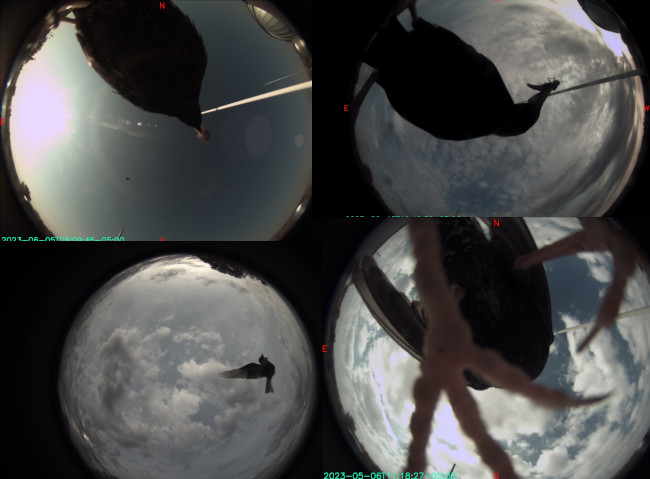Does this sound familiar? You’ve gone through the work of mounting your all-sky camera, you got all the software running, and you love it. But then you notice you are not the only one. Birds love your camera as well!

Birds can not only obstruct the camera’s view of the sky but also soil the all-sky camera dome, which degrades image quality. While looking for a solution, it is essential to avoid a deterrent that might inadvertently obstruct the camera’s sky view.
It’s crucial to take measures that do not harm birds, especially when dealing with protected bird species in your region. Engaging in activities that disrupt these birds or their nesting areas may not only be ethically problematic but also potentially illegal due to conservation regulations.
1. Shinnies – Reflectors (Tape, Spinners, Hangers)
Reflector-type bird deterrents are typically made from materials like aluminum, plastic, or Mylar that have a shiny and reflective surface. Birds are naturally cautious and easily startled by sudden changes in their surroundings. They tend to react to flashes of light and the appearance of movement caused by these reflective surfaces. Additionally, these deterrents can capture sunlight and create noise when the wind blows them, serving as a means to startle and discourage birds. To effectively reduce bird visits around your all-sky camera, you should securely mount these deterrents. Ensure they are firmly anchored to prevent them from being carried away by strong winds during storms.
There are various types of reflector bird deterrents available, including tape, wind veins, and devices resembling wind chimes.
2. Ultrasonic Auditory Alarms
Ultrasonic bird deterrents are devices designed to repel birds from specific areas by emitting high-frequency sound waves that are outside the range of human hearing but within the hearing range of birds. Ultrasonic bird deterrents are non-lethal and humane tools used to discourage birds from roosting, perching, or nesting in unwanted areas.
Birds rely heavily on their acute sense of hearing. When they encounter the ultrasonic sound, it is perceived as annoying and distressing. The continuous, high-pitched noise disrupts their normal communication and navigation, making the area uncomfortable for them.
3. Remove or move any bird feeder or bird houses near the camera
While this might seem straightforward, it’s essential to consider that if you have objects or elements in close proximity to your all-sky camera that are attracting birds, relocating these attractors away from your camera can be an effective strategy to deter bird visits. Birds are drawn to certain environmental cues, such as food sources, nesting sites, or other enticing elements. By removing or relocating these attractors, you can create a less appealing environment for birds around your camera setup, potentially reducing their visits and interference with your equipment.
4. Add an alternative perch/feeder for them.
Conversely, an alternative approach to consider is creating attractive resting spots for birds away from your all-sky camera. The rationale behind this strategy is that if birds have a more appealing place to perch, they may be less inclined to choose your camera location. However, it’s essential to exercise caution, as this might unintentionally encourage even more birds to visit your all-sky camera site.
To implement this approach effectively, you should conduct research on the specific bird species in your area to understand their perching preferences. Different birds favor distinct types of perches. Once you’ve identified these preferences, regularly maintain and clean the alternative perches to ensure they remain inviting to birds. By providing a welcoming environment elsewhere, you can potentially divert bird activity away from your camera setup.
5. Move your all-sky camera to another location
The vicinity surrounding your all-sky camera may feature various factors that entice birds to visit. One such example is when your camera is affixed to a pole, and this pole provides an appealing hole or ledge for birds to construct their nests. In such cases, you might notice an influx of bird activity around your all-sky camera as these birds frequently visit to feed their offspring.
To address this situation, it’s advisable to relocate your all-sky camera to an area that lacks the enticing nesting infrastructure. By moving your camera to a location without attractive nesting options, you can potentially discourage birds from congregating around it, minimizing any disturbances caused by their comings and goings during the nesting season.
Conclusion
When it comes to mitigating bird interference with your all-sky camera, a multifaceted approach can yield the best results. Whether you choose to employ reflective deterrents, create alternative resting spots, or relocate your camera away from bird attractors, understanding the nuances of bird behavior and preferences is key.
Reflective deterrents, such as those made from materials like aluminum, plastic, or Mylar, exploit birds’ natural wariness of sudden movements and flashes of light. By strategically positioning these deterrents, you can reduce bird visits to your camera while maintaining a clear view of the sky.
On the other hand, the creation of attractive perching areas away from your camera can divert bird activity to more hospitable locations. To achieve this, it’s crucial to research the specific bird species in your area and cater to their perching preferences. Regular maintenance is essential to ensure these alternative perches remain enticing to birds.
Additionally, if your camera’s location inadvertently provides nesting opportunities for birds, such as a pole with a convenient hole or ledge, consider relocating your equipment to a less attractive nesting area. This can deter birds from building nests and subsequently visiting your camera during their nesting and feeding cycles.
In all cases, a thoughtful and informed approach is essential to strike the right balance between discouraging bird interference and respecting local wildlife regulations, especially when dealing with protected bird species. By implementing these strategies with care and consideration, you can optimize the performance of your all-sky camera and capture clear, uninterrupted images of the sky.
Hope these tips are helpful. If you would like to share how you’ve dealt with birds contact us and let us know.